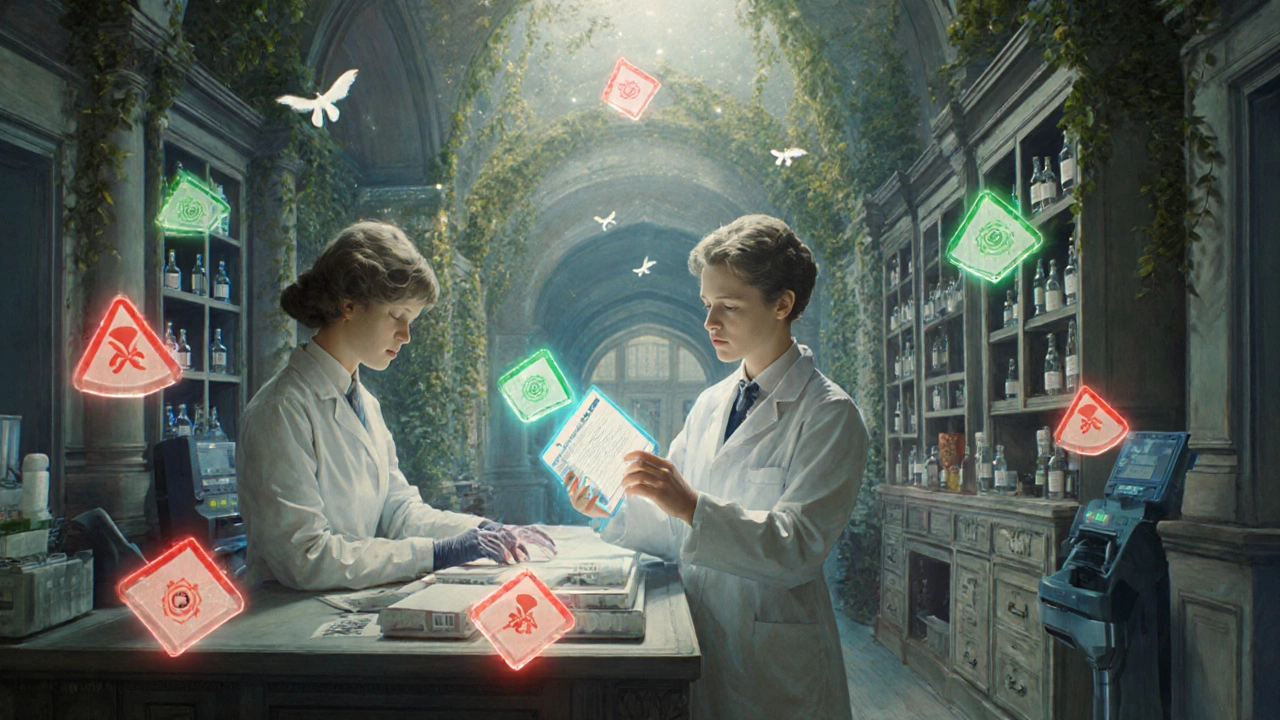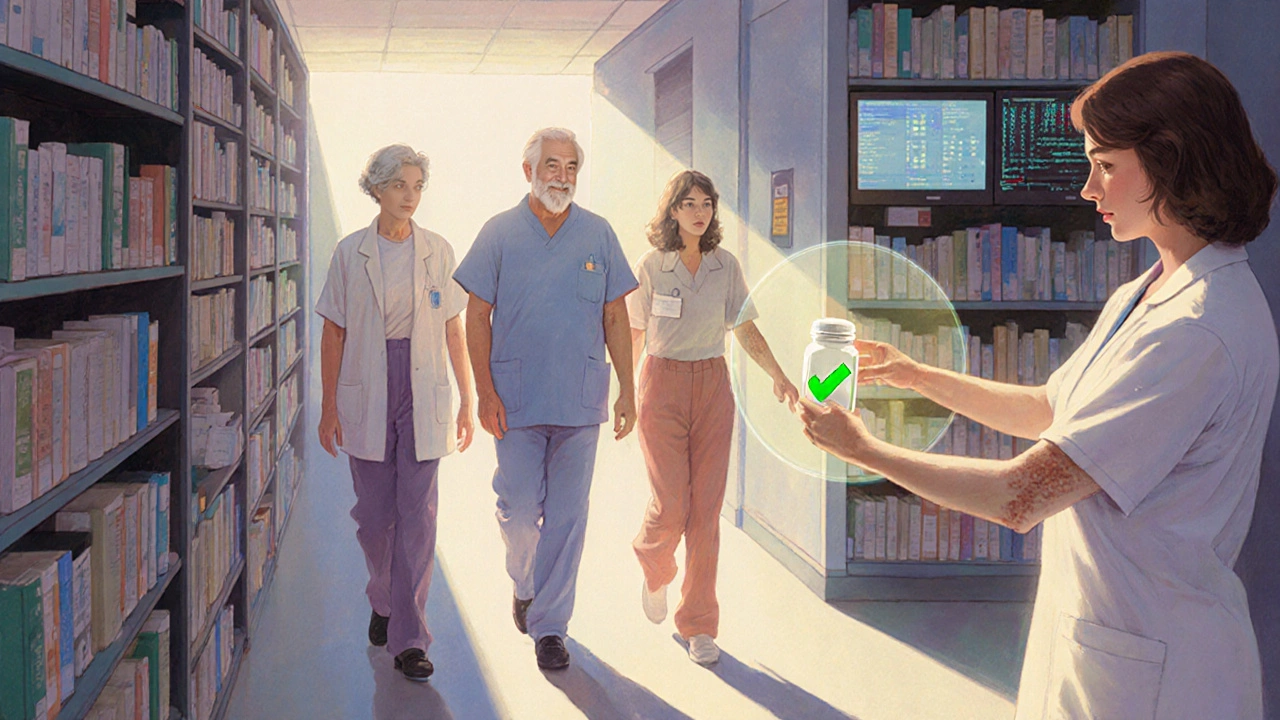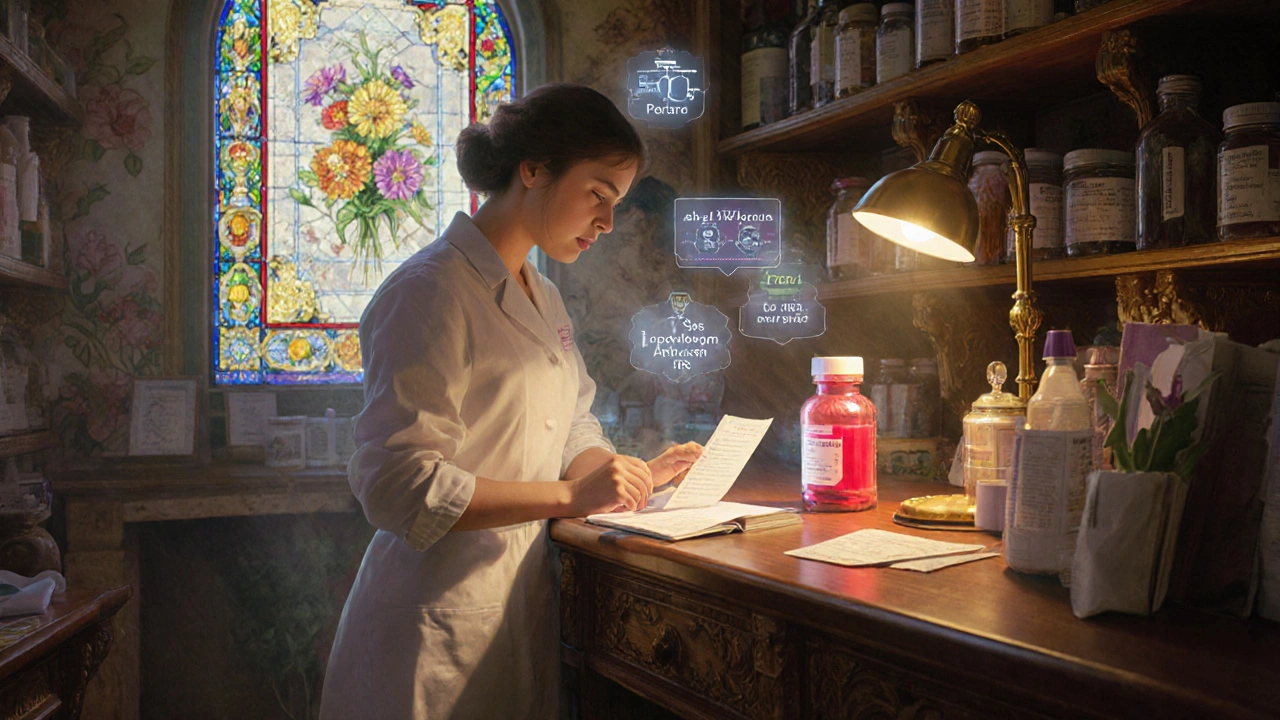Every time you pick up a prescription, a pharmacist is the last person standing between you and a potentially dangerous mistake. It’s not just about counting pills. It’s about catching a 10-fold overdose on warfarin, spotting a drug interaction that could cause kidney failure, or realizing the antibiotic prescribed doesn’t match the patient’s allergy history. These aren’t rare events-they happen hundreds of times a day, and pharmacists stop them before they reach patients.
The Final Check That Saves Lives
Pharmacists are the final safety checkpoint in the medication-use process. By the time a prescription reaches the pharmacy, it’s already passed through a doctor’s office, a digital system, and possibly a nurse or technician. But mistakes still slip through. A handwritten script might be illegible. An electronic order might pick the wrong dose. A patient might have a new allergy that wasn’t updated in the system. That’s where the pharmacist steps in.
According to the Agency for Healthcare Research and Quality, about 1.5 million people in the U.S. are harmed by medication errors every year. Pharmacists prevent roughly 215,000 of those errors annually. That’s not luck. It’s a systematic process built on training, technology, and relentless attention to detail.
How Pharmacists Catch Errors
Pharmacists don’t just glance at a prescription and hand it over. They run a series of checks, both manual and digital. First, they use electronic drug utilization reviews (DUR) that scan the patient’s full medication list. These systems flag dangerous combinations-like mixing blood thinners with certain NSAIDs-or warn if a patient is getting too much of a drug like acetaminophen, which can cause liver damage.
But the software isn’t perfect. It generates alerts-sometimes dozens per prescription. Studies show pharmacists override nearly half of these because they’re low-risk or irrelevant. That’s why experience matters. A skilled pharmacist knows which alerts to trust and which to ignore. They don’t just follow the computer. They think.
They also check for the right dose, the right route, and the right duration. Is this insulin dose appropriate for an elderly diabetic with kidney problems? Is this antibiotic really needed for a viral infection? Is the patient being given a drug that’s known to cause confusion in older adults? These aren’t just technical questions. They’re clinical judgments.
The Role of Technology
Technology helps, but it doesn’t replace the pharmacist. Barcode scanning at the counter cuts dispensing errors by over 50%. Automated dispensing cabinets reduce mistakes by 38%. Electronic prescribing has nearly eliminated errors from bad handwriting-something that used to cause 1 in 5 errors.
In hospitals, pharmacists use medication reconciliation every time a patient is admitted, transferred, or discharged. They compare what the patient was taking at home with what’s being ordered in the hospital. On average, they catch 2.3 medication discrepancies per patient. That’s often a missing dose, a wrong dose, or a drug that shouldn’t be there.
For high-risk drugs like warfarin, insulin, or opioids, pharmacists use a double-check system. Two trained professionals verify the prescription independently. This simple step reduces errors by 42%.
Pharmacy Technicians: The First Line of Defense
Before the pharmacist even sees a prescription, pharmacy technicians are already screening it. They’re the ones who spot confusing drug names-like glipizide and glyburide-or catch prescriptions written in sloppy handwriting. They check National Drug Codes against the label. They verify patient allergies and insurance coverage.
Studies show that when technicians follow a structured verification process, they catch 78% of potential dispensing errors before they reach the pharmacist. That’s why the best pharmacies treat technicians as essential safety partners, not just order-fillers.

Real Stories, Real Errors
One patient in Sydney told their pharmacist they were taking warfarin for atrial fibrillation. The prescription said 5 mg daily. The pharmacist noticed the patient’s INR levels had been stable on 2 mg for months. A quick call to the doctor revealed the prescription had been typed as 10 mg-but the doctor meant 2 mg. The pharmacist caught the 5-fold overdose before the patient left the store.
In another case, a patient picked up a new antibiotic. The pharmacist noticed it was the same drug they’d been prescribed six months ago-and the patient had developed a rash. The pharmacist called the doctor, who realized the wrong antibiotic was being prescribed for a recurrent infection. The patient avoided a dangerous allergic reaction.
These aren’t hypotheticals. They’re daily occurrences. Patients leave reviews on platforms like Yelp describing how pharmacists saved their lives. One wrote: “My pharmacist called me the day after I got my prescription. Said the dose was 10 times too high. I would’ve bled out in my sleep.”
Where the System Falls Short
Pharmacists aren’t superheroes. They’re people working under pressure. In busy community pharmacies, they might fill 200 prescriptions a day. That’s 200 chances for something to slip through.
Alert fatigue is a real problem. When a system throws up 50 alerts for one prescription, even the best pharmacist starts tuning them out. That’s why smart systems now prioritize alerts based on severity. High-risk interactions-like combining SSRIs with certain migraine meds-get flagged first. Low-risk ones get buried.
Another issue? Documentation. In hospitals, error reporting is strong. In independent pharmacies, it’s often inconsistent. If a mistake is caught but not recorded, no one learns from it. That’s why some pharmacies now use simple checklists and mandatory reporting for all intercepted errors.
Why Pharmacists Outperform Technology Alone
Computer systems can reduce errors by 17-25%. Add a pharmacist, and that jumps to 45-65%. Why? Because machines can’t ask, “Is this patient actually taking this?” or “Does this make sense for someone with dementia?”
Pharmacists see the whole picture. They know if the patient can’t afford the medication and might skip doses. They know if the patient is taking herbal supplements that interact with prescriptions. They know if the patient’s family is helping manage the meds-or if they’re living alone with no support.
Studies show pharmacist-led interventions reduce medication error rates by 37% across all settings. They also improve therapeutic appropriateness by 28%. That means patients aren’t just safer-they’re getting better care.

The Bigger Picture: Cost and Value
Preventing one medication error saves an average of $13,847 in healthcare costs. That’s hospital stays, emergency visits, and long-term complications avoided. Across the U.S., pharmacist interventions prevent $2.7 billion in annual costs.
Regulations are catching up. The Joint Commission requires medication reconciliation in hospitals. Medicare now reimburses pharmacists for medication therapy management services. Health systems are hiring more clinical pharmacists-96% of U.S. hospitals now have them on staff.
But there’s a gap. In long-term care facilities, only 38% have dedicated pharmacists. In low-income countries, pharmacist-to-patient ratios can be as high as 1:500. That’s too many patients for one person to safely manage.
What’s Next?
Pharmacists are moving beyond just catching errors. In 27 U.S. states, they can now adjust medications under collaborative practice agreements-like changing blood pressure doses without waiting for a doctor’s approval. AI tools are being developed to help pharmacists focus on the highest-risk prescriptions, cutting their cognitive load by 35%.
By 2027, experts predict pharmacists will prevent 4.3 million medication errors annually-up from 3.3 million today. But that growth depends on one thing: enough trained pharmacists to do the work. Workforce shortages are projected to hit 15,000 by 2025. Without more pharmacists, the system will strain.
What Patients Can Do
You don’t have to wait for the pharmacist to catch a mistake. Ask questions. Know your medications. Bring a list of everything you take-including vitamins and supplements-to every appointment. If a new prescription seems off, ask: “Is this the same dose I was on before?” or “Why is this being added?”
And if your pharmacist stops you-don’t brush them off. They’re not slowing you down. They’re keeping you safe.


Jennifer Walton
November 14, 2025 AT 12:20It’s not magic. It’s routine. They’re just doing their job. But we act like they’re saints because they don’t let us die.
Strange how we forget that until something goes wrong.
Kihya Beitz
November 14, 2025 AT 14:52Oh wow, a pharmacist didn’t kill someone today. Groundbreaking. Next they’ll tell us firefighters put out fires. 🙄
Meanwhile, my script took 45 minutes because they ‘double-checked’ the same damn thing three times. I just want my pills, not a TED Talk.
Ogonna Igbo
November 15, 2025 AT 01:11In Nigeria we have one pharmacist for every 10,000 people and still we survive. You Americans treat pharmacies like temples. You have robots, scanners, AI, 10 layers of checks - and yet you still think you’re special because someone caught a wrong dose?
Here, we use our eyes. Our brains. No machines. We don’t need your 215,000 saved lives statistic - we save lives with less, because we have to. Your system is bloated. We are efficient.
BABA SABKA
November 16, 2025 AT 21:30Let’s be real - this whole narrative is corporate propaganda. Pharmacists are overworked, underpaid, and treated like glorified cashiers until something goes wrong. Then suddenly they’re heroes? The system exploits them for 200 scripts a day and then slaps a ‘life-saving’ badge on them like it’s a free PR win.
And don’t get me started on tech - barcode scanners don’t prevent errors, they just make the pharmacist feel like they’re doing something while the real issue - understaffing - gets ignored.
Pharmacists are the canary in the coal mine. The system is toxic. We need to fix the structure, not praise the person holding the shovel.
Chris Bryan
November 17, 2025 AT 09:20215,000 errors prevented? Sure. But who’s counting? The same people who say vaccines cause autism and the moon landing was faked. Pharmacist ‘checks’ are just a front. The real reason you don’t die is because Big Pharma doesn’t want you suing them. They pay pharmacists to look busy while the real poison is in the supply chain.
Ever heard of the 2012 fungal meningitis outbreak? That was a pharmacy. Coincidence? I think not.
Jonathan Dobey
November 18, 2025 AT 11:38There’s a metaphysical elegance to the pharmacist’s role - the quiet gatekeeper at the threshold of biochemical chaos. They don’t just dispense molecules; they mediate between the fragility of human biology and the arrogance of algorithmic medicine.
Every alert override is a silent act of existential rebellion against the machine’s cold logic. They don’t just catch errors - they restore agency to the body, the mind, the story behind the prescription.
And yet we treat them like automatons in a white coat, rushing them between queues like they’re not the last human voice whispering, ‘Wait. This isn’t right.’
They are the last temple of care in a world that has outsourced empathy to barcode scanners.
ASHISH TURAN
November 19, 2025 AT 21:03Respect to all pharmacists. I’ve seen how hard they work, especially in places where resources are scarce. Even in India, where we don’t have the tech, the knowledge and care are still there. It’s not about the tools - it’s about the person behind the counter.
They’re not just checking doses. They’re checking on people. That’s something no AI can replicate.
Ryan Airey
November 20, 2025 AT 10:16Stop glorifying pharmacists like they’re the only ones stopping errors. Doctors write bad scripts. Nurses input wrong data. EHRs are garbage. The system is a dumpster fire. Pharmacists are the janitors cleaning up after everyone else’s mess.
And yeah, they catch stuff - but they’re also the ones who get blamed when something slips through. Double standards. Always.
Hollis Hollywood
November 21, 2025 AT 07:00I used to work in a pharmacy during college. I saw everything. The elderly woman who came in every week for her blood pressure meds - she didn’t speak English, but the pharmacist would sit with her for 20 minutes, using pictures to explain what each pill did. No one ever thanked him. No one ever noticed.
There’s this quiet dignity in the work. You don’t get applause. You don’t get headlines. You just go home knowing someone didn’t have a stroke because you caught the interaction between their fish oil and their new statin.
It’s not glamorous. But it’s sacred.
Aidan McCord-Amasis
November 22, 2025 AT 21:13Pharmacists are the real MVPs 🙌
Also why does it take 20 minutes to get a Z-pack? Just give me the damn pills 😅
Adam Dille
November 23, 2025 AT 14:37My grandma’s pharmacist remembers her name, her dog’s name, and that she hates grapefruit. He calls her if a new med might mess with her heart pills.
That’s not a job. That’s family.
And yeah, I cry every time I see him. 😭❤️
Katie Baker
November 24, 2025 AT 14:33This is exactly why I always ask my pharmacist if there’s a cheaper option or if I can split the pill. They always know. They’re the unsung heroes of healthcare.
Thank you, pharmacists. You’re doing god’s work.